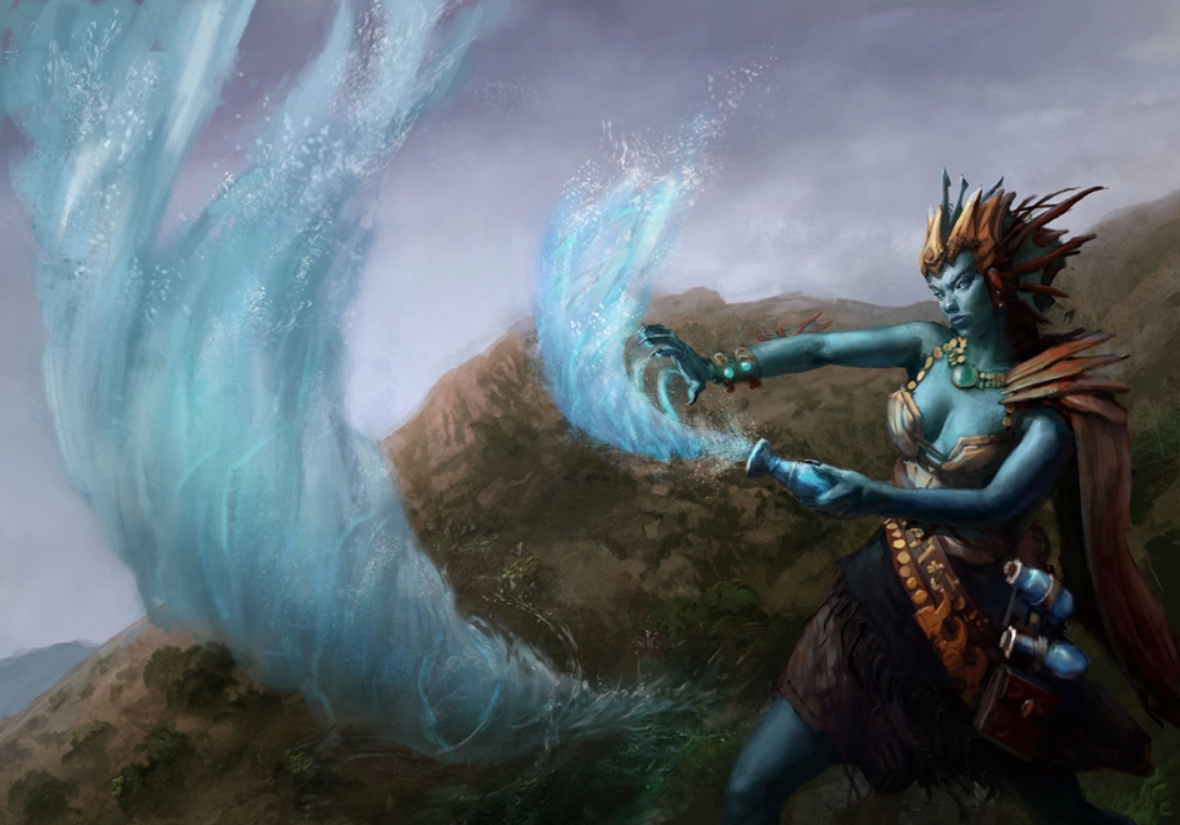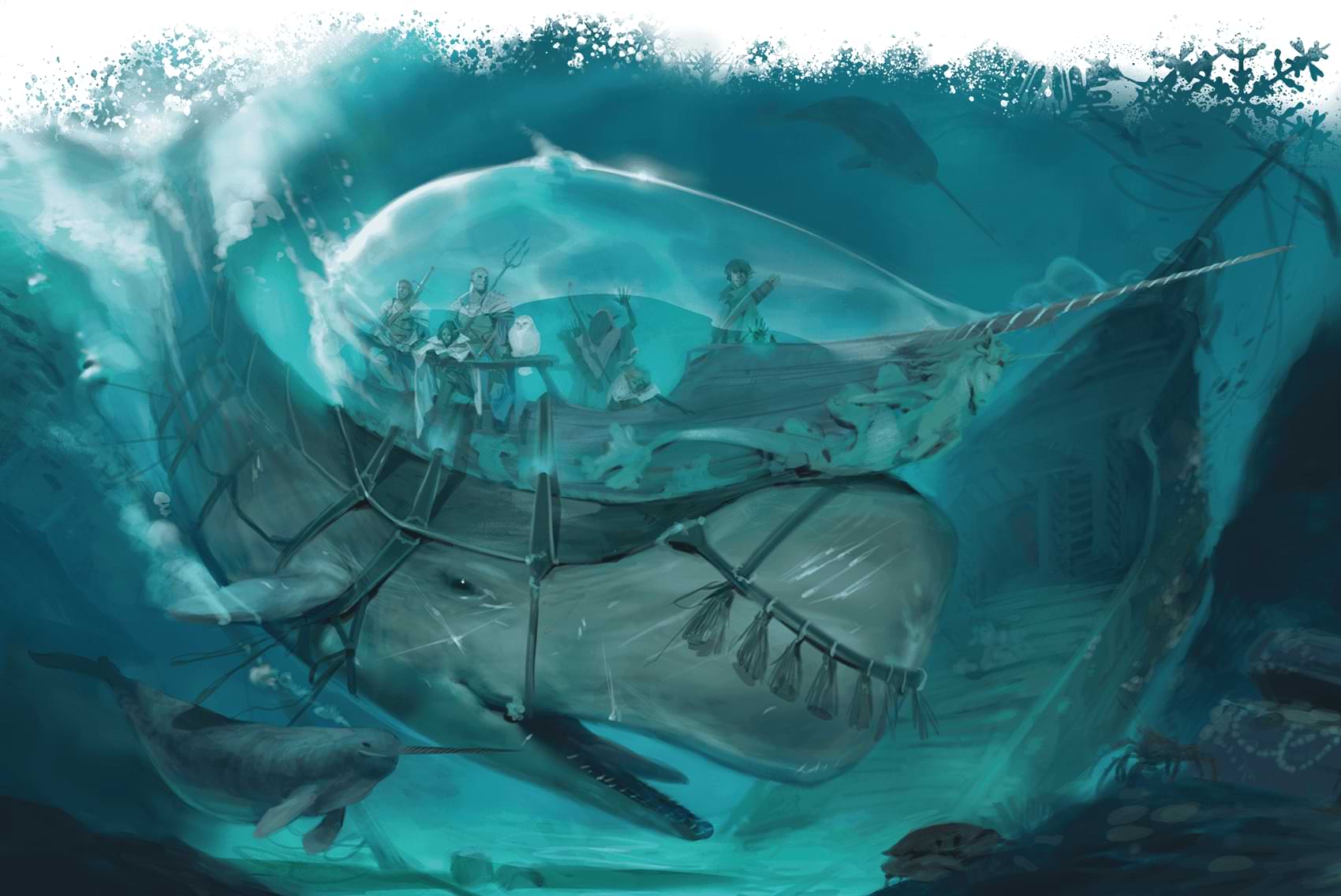Hydration is important. Most would consider it an essential element of survival. But what about those of us who are not content with simply consuming water? What if we won't be satisfied until we unleash our inner Katara and truly bend the wave to our will? If you're looking to make such a splash in your Dungeons & Dragons campaign, maybe it's time to dip your toes into the shape water cantrip found in Xanathar's Guide to Everything!
- What Does Shape Water Do?
- How to Use Shape Water
- Who Can Cast Shape Water?
- Why We Love This Spell
- FAQ: Shape Water
What Does Shape Water Do?

A transmutation cantrip, shape water does exactly what it says on the tin. This useful cantrip allows you to redirect the flow of water that you can see up to 5 feet in any direction. You can even form it into simple animated shapes that will last up to an hour without concentration. These changes aren't just limited to the shape or direction of the water. You can also freeze it or even change its color and opacity, creating ice sculptures or elaborate, literal water ballets.
Deeper Dive
Shape water is a non-combat cantrip, which means that none of its effects can directly be used to damage enemies. The redirected flow doesn't have enough strength to harm an opponent, and the freezing effects cannot trap enemies in a block of ice. This certainly doesn't mean it isn't an extremely useful cantrip to have in your toolbox.
Seafaring adventurers will absolutely appreciate shape water when their ship starts taking on water. The spell's instantaneous casting time means a few somatic casting motions can turn you into a one-being bucket brigade, directing that overflow back out to the sea pronto.
How to Use Shape Water
 The more advanced uses, freezing, shaping, or changing color, can only have up to two effects active at a time. These abilities open up a whole well of potential roleplaying options:
The more advanced uses, freezing, shaping, or changing color, can only have up to two effects active at a time. These abilities open up a whole well of potential roleplaying options:
- Dungeon delvers could use a nearby puddle to leave a liquid message for folks following behind you, such as an arrow or a warning.
- You could make a block of ice to temporarily plug a leak until a more permanent solution can be found.
- A spellcaster could carry a small waterskin in order to pour water into locks, then freeze it to burst them open. Your DM may ask for a skill check using your spellcasting ability modifier to determine whether this succeeds.
- You could leave a slick, slippery surface behind you, forcing enemies to make a DC 10 Dexterity (Acrobatics) check to avoid falling prone. You could even have some hidden icy spikes to cause a more damaging hazard. Your DM would be the judge of how much damage the spikes would do.
- If you're suspicious that a creature lurks inside a murky puddle, you could use the cantrip to reveal them by lifting the water out. An even more subtle approach would be attempting to freeze it to see if the presence of a creature bars you from doing so.
- If you're in a situation where you have to check your weapons to enter a location, prepping a water container ahead of time could provide you with two frozen improvised weapons or shields if you need them.
- If your DM allows you to use the cantrip to make temporary weapons out of holy water, the cantrip's last effect could be a fairly powerful ambush to spring on a vampire.
- If you're a squishy spellcaster caught in the middle of a tough battle, you could make yourself some cover with a chunk of opaque ice. The amount of available water and space could determine if you get half, three-quarters, or full cover according to the cover rules in the Player's Handbook.
- Similarly, if you're trying to create a safer haven to have a short rest, you could make a door out of ice to keep the creepy crawlies of a given dungeon out until naptime is over or at least give you a tiny bit of warning before they invade.
- You could unleash your inner Kevin McCallister and drop or slide a giant block of ice onto your foes.
Who Can Cast Shape Water?
With their connection to the primal magic of the world, druids are a natural fit for shape water. It's also accessible to sorcerers and wizards at character creation. Because it's on the wizard's spell list, a high elf can also select shape water as their cantrip of choice at character creation.
For those thinking outside the bucket, a feat such as Magic Initiate also allows access to shape water. It can also be added via the use of magic items that grant the ability to access a cantrip from any spell list, such as the artificer's all-purpose tool.
Why We Love This Spell
Shape water falls firmly in the bucket of cantrips that have an excellent blend of form and function. Like we said above, it's got some pretty practical applications for use in the game, but it also just begs to be used in ways that flavor the moment and your own character in the process. If you're playing a character who feels drawn to the water, it gives them the ability to craft their own personal World of Color or dancing fountains. It can do a lot to establish a history of having honed their water shaping into an art form.
The aforementioned artificer may have spent their morning analyzing the elemental nature of water in order to properly align their tool to allow themselves to manipulate it. There's a lot of versatility to how you can shape your water to best fit your character, which makes it one of the more aesthetically interesting spells in the game.
FAQ: Shape Water

Can shape water be used to shape other liquids, such as blood or alcohol?
The spell description specifically states water as the target of the spell and not other liquids that may or may not have water as part of their base. However, the opposite is possible. You could use the ability to change the water's opacity or color to trick someone into thinking there has been a bloodbath of a crime scene or by remaining secretly sober while others drink themselves into loosened tongue territory.
Can you use shape water to breathe underwater?
You could use shape water to create a temporary bubble of air around yourself or others in order to pass through a watery space by displacing the water around you. However, you would not be able to create new oxygen once within the bubble, so this would not be a long-term solution or a replacement for higher-level spells to breathe underwater.
Can you unfreeze ice or boil water into steam using shape water?
The cantrip doesn't have the ability to turn water into vapor or melt ice that wasn't created by the spell itself. However, teamwork makes the dream work, and perhaps partnering with a fellow party member utilizing create bonfire or fire bolt could still lead to a 5-foot cube of boiling water that is now at your beck and call.
Can you create snow with shape water?
Using the freeze feature, you could create snow from falling rain or water pouring down from above. Of course, you would have to keep casting the spell as the water moved in and out of the area, and the water you had previously frozen would then unfreeze due to the two-at-a-time active effects restriction on that ability. But it would certainly look cool.
Riley Silverman (@rileyjsilverman) is a contributing writer to D&D Beyond, Nerdist, and SYFY Wire. She DMs the Theros-setDice Ex Machinafor the Saving Throw Show, and has been a player on the Wizards of the Coast-sponsoredThe Broken Pact. Riley also played as Braga in the official tabletop adaptation of theRat Queenscomic for HyperRPG, and currently plays as The Doctor on the Doctor Who RPG podcastThe Game of Rassilon. She currently lives in Los Angeles.








-
View User Profile
-
Send Message
Posted Jan 3, 2023You sound like a fun DM...
Also the spell allows for two effects at a time.
-
View User Profile
-
Send Message
Posted Jan 3, 2023As much as I like the idea of being able to bust open a lock by freezing water in it, I'd probably rule that since other uses proposed by the spell state it "doesn't have enough force to cause damage", that freezing it wouldn't be able to damage the lock.
Yes, i know, water expands when it freezes, but if we're not going to consider other water-containing liquids like blood or alcohol or acid as water, then i'm not going to consider the physics of phase changes either.
-
View User Profile
-
Send Message
Posted Jan 3, 2023I actually agree with @generic_poster. I have been in a session where one player did this one time after another. Which made everyone else bored and the DM then had to counter it. Which seems petty because its clear he had to do it. This usage sort of reminds me what happens with guidance. just a mechanic - no fun role play after a while.
-
View User Profile
-
Send Message
Posted Jan 4, 2023In my ruling, for the cantrip to freeze water inside a lock in a way that breaks it, the freezing energy has to spread out after it passes the keyhole and reach throughout the liquid to cause it to freeze solid. An arcana check (DC dependent on lock) seems appropriate, with advantage granted by proficiency with Thieves' Tools (per XGTE) because of the character's familiarity with the interior mechanics of locks, assuming it's a common lock design.
Without this delicate approach, you're more likely to explode a big loud broken circle of crumpled wood in the door (and probably jam the dang thing) by suddenly blindly freezing a bunch of water in a big blob. Anyone who has tried to deal with a waterlogged, warped door might know that it can be worse than a lock.
-
View User Profile
-
Send Message
Posted Jan 5, 2023We weren't allowed to freeze locks with shape water unfortunately. But, what I have done in play with DM approval is use the spell to make an imprint of a key of a lock - This was done by having a barrel of water near by said lock, moving water into the lock and freezing the water into an icy replica key. Then I had to remove it without damaging it with another player ready to quickly use stone shape to craft an actual key from the watery ice mold. Then we used that key to open the door.
Edit: Restructured my sentence
-
View User Profile
-
Send Message
Posted Jan 5, 2023THIS IS AWESOME THE CRAZY AMOUNTS OF DEATAIL THEY PUT IN TO THIS!
-
View User Profile
-
Send Message
Posted Jan 5, 2023i like the collaborative elements in this. thanks for sharing!
-
View User Profile
-
Send Message
Posted Jan 6, 2023The spell describes the area as a 5-foot cube: that's 125 cubic feet. That's nearly FOUR TONS of water!
Now I get that the spell itself can't do damage, but the consequences of using the spell creatively can do SO much damage!
-
View User Profile
-
Send Message
Posted Jan 7, 2023My girlfriend, in a one-shot, chose two magic items for her 5th-level kobold sorcerer: Decanter of Endless Water and Slippers of Spider Climbing. During a fight, her character was walking upside down on a tree's large branch over an enemy.
Her: "Okay, I open my Decanter while standing above him and I say 'geyser'."
DM: "Okay, so-"
Her: "And then I spend two sorcery points to Quicken Spell and cast Shape Water to freeze the geyser into icicles."
DM: *bursts into uproarious laughter*
-
View User Profile
-
Send Message
Posted Jan 7, 2023Had an interesting discussion about this on DM Lair live chat recently. I wondered about the "dropping a giant cube of ice" scenario, and through some discussion I came to the conclusion that it would be possible to use separate actions over the course of two turns to:
Gravity would cause the block of ice to fall and the thin tail to shatter under the weight, and at minimum, you could cause 2d6 damage (1d6 for every 10ft of falling for any objects over 200lb). It does seem to be a little underpowered considering the fact that several thousand pounds of ice would be falling on your target, but then it's also a cantrip available to first-level players. So, how powerful do you want it to be? It would also be very obvious to any enemy, so even if they didn't take the opportunity to move out of the way after the first round, I would give them a DC 5-10 Dex saving throw to avoid injury entirely.
During my conversation, it was decided that the maximum height of the fall above ground level (assuming water, spellcaster, and target are all on the same level) could only be determined by the range of the spell, in other words, if the shape were to extend beyond 30ft, the water would simply begin falling naturally as if no longer affected by any magic. however, there was a lot of back and forth over whether the shape itself could extend beyond the 5x5x5ft area. Some were adamant that it couldn't, but then that would limit a great range of other uses. Many of which are mentioned in this article. Anyway, there you go, that's the mechanic limitation I'm running.
Over the course of two turns (or12 seconds), you can drop a 3-ton block of ice on a really dumb and slow enemy standing within 10ft of you from 25ft up and cause 2d6 damage +1d6 (to a maximum of 20d6) for every additional 10ft if they're underneath the cliff/tower/platform you're standing on. They take no damage on a successful DC 10 dex save. If they are surprised by the attack, they roll with disadvantage.
-
View User Profile
-
Send Message
Posted Jan 8, 2023If the Icewind Dale campaign where I was playing a water genasi had continued long enough, I wanted to have her shape a 5' cube of water into a sphere, then instantly freeze it solid and roll it down a hill at some enemies. Given the density of ice and the size of the sphere, that's over 16 tons rolling down over them. :D
-
View User Profile
-
Send Message
Posted Jan 9, 2023I would just rule that this does 1d8 bludgeoning damage to the lock. We already have similar game mechanics, no need to rule lawyer ourselves into oblivion. :)
-
View User Profile
-
Send Message
Posted Jan 9, 2023THIS LOOKS SICK!!!!!!
-
View User Profile
-
Send Message
Posted Jan 10, 2023What about creating a 5ft Cube of Ice and dropping it on your foes? That cube would weigh around 3300lbs. Is that not enough to damage an enemy?
-
View User Profile
-
Send Message
Posted Jan 11, 2023Using the "Improvising Damage" table in the DMG, it would do around 4d10 bludgeoning damage. That is assuming you have a 5ft cube of water and a mechanism to drop it onto something, since the spell itself doesn't allow you to lift blocks of ice. You'll have to set up a fairly elaborate trap for that, and at that point it's easier to just use falling rubble.
-
View User Profile
-
Send Message
Posted Jan 11, 2023See my comment 4 posts above yours.
-
View User Profile
-
Send Message
Posted Jan 14, 2023Pykrete is made of 14% sawdust and 86% water by mass. has three times the tensile strength of concrete
-
View User Profile
-
Send Message
Posted Jan 14, 2023It can move 5 cubic feet of water. That's 37 gallons of water you can move at a time, and you can cast the spell indefinitely every six seconds, that's 370 gallons of water a minute. Yeah, I think that could save a sinking ship. And that's just from one spell caster
-
View User Profile
-
Send Message
Posted Jan 15, 20235-foot cube, not 5 cubic feet.There's a HUGE difference!
A 5x5x5-foot cube is 125 cubic feet (937.5 gallons), which works out to a little over 7800lbs. (62.4lb/ft*3 for freshwater: seawater is a bit heavier at 64lb/ft*3)
That's not just a bilge pump, that's a fire hose! Except without the pressure, cause it can't do damage?
-
View User Profile
-
Send Message
Posted Jan 17, 2023Oh, crap! You're right! This is what happens when you late night math lol. Thanks for that